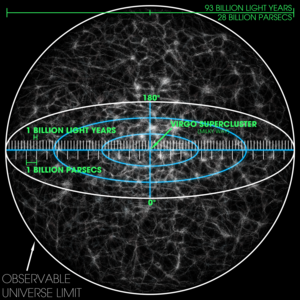เอกภพที่สังเกตได้
 การแสดงภาพของเอกภพที่สังเกตได้ทั้งหมด สเกลเป็นแบบที่เกรนละเอียดแสดงถึงคอลเล็กชันของซูเปอร์คลัสเตอร์จำนวนมาก Virgo Supercluster—บ้านของทางช้างเผือก—มีเครื่องหมายอยู่ตรงกลาง แต่เล็กเกินกว่าจะมองเห็นได้ | |
| เส้นผ่านศูนย์กลาง | 8.8×1026 m or 880 Ym (28.5 Gpc or 93 Gly)[1] |
|---|---|
| ปริมาณ | 3.566×1080 m3[2] |
| มวล (สารธรรมดา) | 1.5×1053 kg[note 1] |
| ความหนาแน่น (ของพลังงานทั้งหมด) | 9.9×10−27 kg/m3 (เทียบเท่ากับ 6 โปรตอน ต่อพื้นที่หนึ่งลูกบาศก์เมตร)[3] |
| อายุ | 13.799±0.021 พันล้านปี[4] |
| อุณหภูมิเฉลี่ย | 2.72548 K[5] |
| เนื้อหา |
|

ตามทฤษฎีบิกแบง เอกภพที่สังเกตได้ (อังกฤษ: Observable Universe) คือขอบเขตห้วงอวกาศในกรอบทรงกลมที่มีจุดศูนย์กลางที่ผู้สังเกตการณ์ ที่มีขนาดเล็กพอที่เราจะสังเกตวัตถุต่าง ๆ ภายในได้ เช่น ระยะเวลาที่นานพอสำหรับการแพร่สัญญาณจากวัตถุ ณ เวลาใด ๆ หลังเหตุการณ์บิกแบง มีการเคลื่อนที่เท่าความเร็วแสง และเดินทางมาถึงผู้สังเกตการณ์ ณ เวลาปัจจุบัน ทุก ๆ ตำแหน่งมีเอกภพที่สังเกตได้ของจุดนั้น ๆ ซึ่งอาจพอดีหรือเหลื่อมกันกับเอกภพที่สังเกตได้จากโลก ในทางทฤษฎีเอกภพที่สังเกตได้อาจมีขนาดเล็กกว่าหรือใหญ่กว่าขนาดของเอกภพจริง

ดูเพิ่ม
[แก้]- เอกภพ
- ขอบฟ้าเหตุการณ์ (Event Horizon)
- ขอบฟ้าจักรวาลวิทยา (Cosmological Horizon)
แหล่งข้อมูลอื่น
[แก้]| ประกอบด้วย | โลก → ระบบสุริยะ → กลุ่มเมฆระหว่างดาวท้องถิ่น → ฟองท้องถิ่น → แถบกูลด์ → แขนนายพราน → ทางช้างเผือก → กลุ่มย่อยทางช้างเผือก → กลุ่มท้องถิ่น → แผ่นท้องถิ่น → กลุ่มกระจุกดาราจักรหญิงสาว → กลุ่มกระจุกดาราจักรลาเนียเคอา → ที่ว่าง เคบีซี → เอกภพที่สังเกตได้ → เอกภพ แต่ละ ลูกศร (→) อาจอ่านได้ว่า "อยู่ใน" หรือ "เป็นส่วนหนึ่งของ" |
|---|---|
| ที่เกี่ยวข้อง |
|
- ↑ Itzhak Bars; John Terning (2009). Extra Dimensions in Space and Time. Springer. pp. 27–. ISBN 978-0-387-77637-8. สืบค้นเมื่อ 2011-05-01.
- ↑ "volume universe - Wolfram|Alpha". www.wolframalpha.com.
- ↑ "What is the Universe Made Of?". NASA. สืบค้นเมื่อ June 1, 2022.
- ↑ Planck Collaboration (2016). "Planck 2015 results. XIII. Cosmological parameters (See Table 4 on page 32 of pdf)". Astronomy & Astrophysics. 594: A13. arXiv:1502.01589. Bibcode:2016A&A...594A..13P. doi:10.1051/0004-6361/201525830. S2CID 119262962.
- ↑ Fixsen, D. J. (December 2009). "The Temperature of the Cosmic Microwave Background". The Astrophysical Journal. 707 (2): 916–920. arXiv:0911.1955. Bibcode:2009ApJ...707..916F. doi:10.1088/0004-637X/707/2/916. S2CID 119217397.
- ↑ "Planck cosmic recipe".
อ้างอิงผิดพลาด: มีป้ายระบุ <ref> สำหรับกลุ่มชื่อ "note" แต่ไม่พบป้ายระบุ <references group="note"/> ที่สอดคล้องกัน
Text is available under the CC BY-SA 4.0 license; additional terms may apply.
Images, videos and audio are available under their respective licenses.
